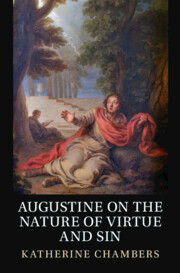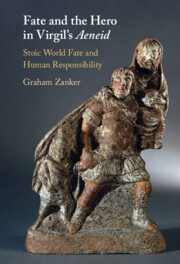105 results
PHILOSOPHY IN DIO CHRYSOSTOM, ON ANACHÔRÊSIS (ORATION 20)
-
- Journal:
- The Classical Quarterly , First View
- Published online by Cambridge University Press:
- 03 June 2024, pp. 1-13
-
- Article
- Export citation
Chapter 11 - Doing Things with Concepts in Sextus Empiricus
-
-
- Book:
- Conceptualising Concepts in Greek Philosophy
- Published online:
- 25 April 2024
- Print publication:
- 02 May 2024, pp 259-284
-
- Chapter
- Export citation
Chapter 13 - Philosophy
-
-
- Book:
- The Cambridge Critical Guide to Latin Literature
- Published online:
- 04 January 2024
- Print publication:
- 18 January 2024, pp 700-752
-
- Chapter
- Export citation
6 - The Life in Accordance with Nature
-
- Book:
- Augustine on the Nature of Virtue and Sin
- Published online:
- 10 January 2024
- Print publication:
- 23 November 2023, pp 207-239
-
- Chapter
- Export citation

Augustine on the Nature of Virtue and Sin
-
- Published online:
- 10 January 2024
- Print publication:
- 23 November 2023
4 - Augustine’s Definitions of Virtue
-
- Book:
- Augustine on the Nature of Virtue and Sin
- Published online:
- 10 January 2024
- Print publication:
- 23 November 2023, pp 119-162
-
- Chapter
- Export citation
4 - The Religions of India
-
- Book:
- Learning from Other Religions
- Published online:
- 30 October 2023
- Print publication:
- 16 November 2023, pp 115-167
-
- Chapter
- Export citation
Chapter 8 - Philosophical Tale
- from Part II - Genres
-
-
- Book:
- The Cambridge Companion to <i>Gulliver's Travels</i>
- Published online:
- 05 October 2023
- Print publication:
- 19 October 2023, pp 96-108
-
- Chapter
- Export citation
Chapter 8 - Intertextuality and Posthumous Reputation in Pliny’s Letter on the Death of Silius Italicus (Plin. Ep. 3.7)
- from Part III - Pliny and Seneca: Discourses of Grief and Posthumous Reputation
-
-
- Book:
- Intertextuality in Pliny's <i>Epistles</i>
- Published online:
- 07 September 2023
- Print publication:
- 21 September 2023, pp 164-184
-
- Chapter
- Export citation
Self and selfishness in Late Antiquity: Plotinus on oikeiōsis
-
- Journal:
- The Journal of Hellenic Studies / Volume 143 / November 2023
- Published online by Cambridge University Press:
- 15 September 2023, pp. 222-249
- Print publication:
- November 2023
-
- Article
-
- You have access
- Open access
- HTML
- Export citation
Chapter 6 - Women at the Crossroads
-
-
- Book:
- Ancient Women Philosophers
- Published online:
- 17 August 2023
- Print publication:
- 31 August 2023, pp 114-133
-
- Chapter
- Export citation
6 - De Officiis and Exemplary Ethics
- from Part III - Exemplary Ethics
-
-
- Book:
- Cicero's ‘De Officiis'
- Published online:
- 15 June 2023
- Print publication:
- 29 June 2023, pp 119-138
-
- Chapter
- Export citation
5 - Cicero’s De Officiis on Practical Deliberation
- from Part II - The Role of Virtue
-
-
- Book:
- Cicero's ‘De Officiis'
- Published online:
- 15 June 2023
- Print publication:
- 29 June 2023, pp 97-116
-
- Chapter
- Export citation
Introduction
-
-
- Book:
- Cicero's ‘De Officiis'
- Published online:
- 15 June 2023
- Print publication:
- 29 June 2023, pp 1-12
-
- Chapter
- Export citation
10 - Patriotism and Cosmopolitanism in Cicero’s De Officiis
- from Part V - Politics
-
-
- Book:
- Cicero's ‘De Officiis'
- Published online:
- 15 June 2023
- Print publication:
- 29 June 2023, pp 203-223
-
- Chapter
- Export citation
Taxing Wealth in the Just City: Cicero and the Roman Census
-
- Journal:
- The Journal of Roman Studies / Volume 113 / November 2023
- Published online by Cambridge University Press:
- 06 June 2023, pp. 1-27
- Print publication:
- November 2023
-
- Article
-
- You have access
- Open access
- HTML
- Export citation
Introduction
-
- Book:
- Fate and the Hero in Virgil's <I>Aeneid</I>
- Published online:
- 06 April 2023
- Print publication:
- 13 April 2023, pp 1-8
-
- Chapter
- Export citation

Fate and the Hero in Virgil's Aeneid
- Stoic World Fate and Human Responsibility
-
- Published online:
- 06 April 2023
- Print publication:
- 13 April 2023
Chapter 3 - The Treatise On Benefits
- from Part I - Recreating the Stoic Past
-
- Book:
- Seneca
- Published online:
- 23 March 2023
- Print publication:
- 30 March 2023, pp 57-84
-
- Chapter
- Export citation
Chapter 8 - Anatomies of Joy
- from Part III - Models of Emotional Experience
-
- Book:
- Seneca
- Published online:
- 23 March 2023
- Print publication:
- 30 March 2023, pp 176-192
-
- Chapter
- Export citation



